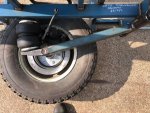Thank you all for the replies. Between full time work, college classes/homework for 20 hours a week, and house/vehicle repairs I'm a bit busy, it makes spending time researching and digging for information a bit hard right now.. My apologies for the slow response time.
I appreciate the wealth of information. The trailer, I'm wanting to build is a small single axle. Well, minus the axle. I'd like a flat bed, but, one that can be changed in order to be used as a expedition trailer. While this may seem not possible to most, I had made a 4x8 trailer a few years ago, that had a removable flat deck with extensions. When the deck was removed, it was just a frame. I had a set of Kayak mounting racks allowing for 4 to be loaded. I had a few other mounts for motorcycles and lumber. I had plans for a small camper pod that could be attached also, a teardrop style, however I never built it. The trailer was lighter duty than what I would want now. It also was very tall, while not a problem for my dodge ram, it would be way to tall for my subaru outback. It also, didn't perform well off road. I sold it about a year and a half ago.
My issue with normal axles is the very poor off road handling. yes, I have tried. I also find, that having to order a special size axle to be more costly than what it is worth, especially with the lesser performance. I'm not a fan of torsion axles either. I found pictures of many independent arm/coil suspensions and videos of how well they work off road. I'd like to think with this suspension, and a redesign of my original trailer coupled with some material changes, I can create a smaller, more useful better adapted trailer. As far as airbags, I've seen a few failures that keep me wanting something that is a bit more sound. It would be nice to be able to adjust the coil tension or travel to change load on the springs, but not sure that can really be done.
I am mostly looking to pull this behind my Outback, while small, it can tow 2700 lbs. I'm not looking to exceed 1,500lbs even. I figure a small trailer with a more rigid frame that can be reconfigured, with a small storage pod and either rooftop tent or folding hard shell sleeper would be the trick. A removable tongue that allows for a high or low one to be installed for the truck, or car. Just a month and half ago, I went to the UP in Michigan, I went down many trails to remote state camp sites. Some spots, even a small truck was to tall to access. I slept in my Outback, but, I had no toilet or shower. No stove/grill. Nothing but the bed, a spare tire, fuel packs on my roof rack, along with a winch, farm jack, shovel and boards. It was fun... but I'd like a bit more ability to be away from towns/cities.
Thanks to all who replied. - Unholy

